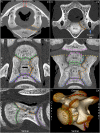Closure of the neuro-central synchondrosis and other physes in foal cervical spines
- PMID: 38594893
- PMCID: PMC11616957
- DOI: 10.1111/evj.14093
Closure of the neuro-central synchondrosis and other physes in foal cervical spines
Abstract
Background: The neuro-central synchondrosis (NCS) is a physis responsible for the growth of the dorsal third of the vertebral body and neural arches. When the NCS of pigs is tethered to model scoliosis, stenosis also ensues. It is necessary to describe the NCS for future evaluation of its potential role in equine spinal cord compression and ataxia (wobbler syndrome).
Objectives: To describe the NCS, including when it and other physes closed in computed tomographic (CT) scans of the cervical spine of foals, due to its potential role in vertebral stenosis.
Study design: Post-mortem cohort study.
Methods: The cervical spine of 35 cases, comprising both sexes and miscellaneous breeds from 153 gestational days to 438 days old, was examined with CT and physes scored from 6: fully open to 0: fully closed. The dorsal physis, physis of the dens and mid-NCS were scored separately, whereas the cranial and caudal NCS portions were scored together with the respective cranial and caudal vertebral body physes.
Results: The NCS was a pair of thin physes located in a predominantly dorsal plane between the vertebral body and neural arches. The mid-NCS was closed in C1 from 115 days of age, and in C2-C7 from 38 days of age. The dorsal physis closed later than the NCS in C1, and earlier than the NCS in C2-C7. The dens physis was closed from 227 days of age. The cranial and caudal physes were closing, but not closed from different ages in the different vertebrae of the oldest cases.
Main limitations: Hospital population.
Conclusions: The NCS was a thin physis that contributed mainly to height-wise growth, but also width- and length-wise growth of the vertebral body and neural arches. The mid-NCS was closed in all cervical vertebrae from 115 days of age. The NCS warrants further investigation in the pathogenesis of vertebral stenosis.
Historial: La sincondrosis neuro‐central (NCS) es la fisis responsable del crecimiento del tercio dorsal del cuerpo vertebral y de los arcos neurales. Cuando la NCS en cerdos se asocia a un modelo de escoliosis, también se produce estenosis. Es necesario describir la NCS para la futura evaluación de su rol potencial en la comprensión de la medula espinal equina y ataxia (síndrome de Wobbler).
Objetivos: Describir la NCS incluyendo cuando ella y otras fisis se cierran, por tomografía computarizada (CT) de la columna cervical de potrillos, debido a su rol potencial en la estenosis vertebral. DISEÑO DEL ESTUDIO: Estudio de cohorte post‐mortem. MÉTODOS: La columna cervical de 35 casos, incluyendo ambos sexos y diferentes razas, desde 153 días gestacionales hasta 438 días de edad, fueron examinadas por CT y las fisis fueron dadas un puntaje de, 6: completamente abiertas a, 0: completamente cerradas. La fisis dorsal, la fisis del hueso odontoides y NCS media fueron evaluadas en forma separada, mientras las porciones de NCS craneal y caudal fueron evaluadas juntas con las respectiva fisis del cuerpo vertebral craneal y caudal.
Resultados: La NCS es un par de fisis delgadas localizadas predominantemente en el plano dorsal entre el cuerpo vertebral y los arcos vertebrales. La NCS media estaba cerrada en C1 desde los días 115 de edad, y en C2‐C7 a partir de los 38 días de edad. La fisis dorsal se cerró más tarde que la NCS en C1, y antes que la NCS en C2‐C7. La fisis del hueso odontoides estaba cerradas a partir de los 227 días de edad. Las fisis craneal y caudal estaban cerrándose, pero no estaban cerradas a distintas edades en las diferentes vertebras en los casos mayores de edad.
Limitaciones principales: Población de hospital CONCLUSIONES: La NCS es una fisis delgada que contribuye principalmente al crecimiento en altura, pero también en ancho y largo del cuerpo vertebral y arcos vertebrales. La NCS media estaba cerrada en todas las vértebras cervicales a partir de los 115 días de edad. La NCS merece ser investigada más en la patogénesis de la estenosis vertebral. Palabras Clave: ataxia, tomografía computarizada, caballo, osteocondrosis, estenosis, crecimiento vertebral.
Keywords: ataxia; computed tomography; horse; osteochondrosis; stenosis; vertebral growth.
© 2024 The Authors. Equine Veterinary Journal published by John Wiley & Sons Ltd on behalf of EVJ Ltd.
Conflict of interest statement
The authors have declared no conflicting interests.
Figures






References
-
- Olstad K, Aasmundstad T, Kongsro J, Grindflek E. Osteochondrosis and other lesions in all intervertebral, articular process and rib joints from occiput to sacrum in pigs with poor back conformation, and relationship to juvenile kyphosis. BMC Vet Res. 2022;18(1):44. 10.1186/s12917-021-03091-6 - DOI - PMC - PubMed
-
- Maierl J, Zechmeister R, Schill W, Gerhards H, Liebich HG. Radiologic description of the growth plates of the atlas and axis in foals. Tierarztl Prax Ausg G Grosstiere Nutztiere. 1998;26(6):341–345. - PubMed
-
- Wissdorf H, Gerhards H, Huskamp B, Deegen E. Praxisorientierte Anatomie und Propädeutik des Pferdes (Practice‐oriented anatomy and propedeutics of the horse). 3rd ed. Hannover, Germany: M. & H. Schaper Verlag GmbH; 2010.
MeSH terms
Grants and funding
LinkOut - more resources
Full Text Sources
Medical
Miscellaneous

